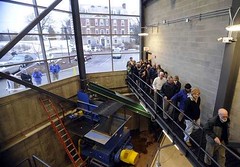A roving compendium of ecocentric energy options, including advances in solar and wind power, hybrid vehicles, and other thoughtful, balanced approaches to renewable energy.
Sunday, April 13, 2014
Sunday, September 19, 2010
Saab Goes Electric

From borderline extinction to a surprising renaissance under the Dutch firm Spyker, Saab may still have some innovative ideas left in its automotive bag of tricks. The company has unveiled its first electric car, an introduction which should help keep alive its reputation as an idiosyncratic but forward-looking auto manufacturer, as reported by AllCarsElectric.
Mats Fägerhag, Executive Director of Vehicle Engineering at Saab Automobile, says that "this program is designed to evaluate the potential for developing a high performance, zero emission electric vehicle and is an important next-step in the extension of our EcoPower propulsion strategy".
Let's hope that this is a positive step toward recovery for a car company that (at least until the GM years) always bristled with personality.
Tuesday, June 15, 2010
RMI's Reinventing Fire initiative launched
Saturday, February 27, 2010
Attack of the Deniers

A few snowstorms bring out the climate change deniers in force, proudly displaying their ignorance in mistaking meterological events with long-term climate trends. The winter of 2009/2010 has given them an unexpected windfall of events to use as ammunition in their misinformation campaigns, which appear to be working: more and more Americans no longer believe climate change is a matter of importance.
A TomDispatch article by Bill McKibben, one of the first writers to sound the global warming alarm as scientific studies came to light, examines the phenomenon of the denier movement and considers their tactics and motivation.
The fact that the media gives the skeptics high-profile coverage is one reason behind the diminishing belief in climate change, despite overwhelming and growing body of scientific evidence.
The climate deniers come with a few built-in advantages. Thanks to Exxon Mobil and others with a vested interest in debunking climate-change research, their “think tanks” have plenty of money, none of which gets wasted doing actual research to disprove climate change. It’s also useful for a movement to have its own TV network, Fox, though even more crucial to the denial movement are a few rightwing British tabloids which validate each new “scandal” and put it into media play.
That these guys are geniuses at working the media was proved this February when even the New York Times ran a front page story, “Skeptics Find Fault With U.N. Climate Panel,” which recycled most of the accusations of the past few months. What made it such a glorious testament to their success was the chief source cited by the Times: one Christopher Monckton, or Lord Monckton as he prefers to be called since he is some kind of British viscount. He is also identified as a “former advisor to Margaret Thatcher,” and he did write a piece for the American Spectator during her term as prime minister offering his prescriptions for “the only way to stop AIDS”:
"...screen the entire population regularly and… quarantine all carriers of the disease for life. Every member of the population should be blood-tested every month... all those found to be infected with the virus, even if only as carriers, should be isolated compulsorily, immediately, and permanently.”
He speaks with equal gusto and good sense on matters climatic -- and now from above the fold in the paper of record.
While the fossil-fuel companies fight furiously to dispute climate science, McKibben notes that the Chinese are already taking advantage of American inaction.
Right now, China is gearing up to dominate the green energy market. They’re making the investments that mean future windmills and solar panels, even ones installed in this country, will be likely to arrive from factories in Chenzhou, not Chicago.
McKibben's upcoming book is Eaarth: Making a Life on as Tough New Planet.
Friday, March 27, 2009
Middlebury College Becoming Carbon Neutral

With a target to achieve carbon neutral operations by 2016, Middlebury College in Vermont has taken a major first step in that direction with the completion of a $12 million dollar biomass boiler and plant. Bill McKibben, whose organization 350.org is playing a major role in calling for a fair global climate treaty, participated in the opening ceremonies and gave a lecture on the importance of reducing greenhouse gas emissions/
At optimal capacity, which the plant is expected to reach over the next month, the facility will consume about three tons of wood chips an hour and meet about half the campus’s heating, cooling and hot-water needs. The other half will still be supplied by boilers that burn No. 6 fuel oil, but the overall campus use of such oil will be cut in half, from 2 million gallons a year to 1 million. As a result, the college’s carbon dioxide emissions will be reduced about 40 percent, or 12,500 metric tons a year.
Middlebury College is working to develop its own supply and wood chips on its surrounding property and also investigating the potential of geothermal energy for further reducing carbon emissions. More details are available in this article, orginally published in the Burlington Free Press.
Saturday, March 07, 2009
Students Protest Coal on Capitol Hill
Sunday, March 01, 2009
Beyond the Stimulus: A Global Green Deal

With indications that global warming is accelerating faster than many earlier computer models predicted, you would think that this information would spur a concerted global effort to reverse the trend. But so far the response of most governments around the world has been fairly tepid and the levels of greenhouse gas emissions continue to rise in those countries most responsible for the problem.
In a recent article for The Nation, A Global Green Deal, Mark Hertsgaard makes a case for a massive program of green investment to lift people out of poverty, stimulate the worldwide economy, and reduce greenhouse gas emissions.
Hertsgaard believes the Obama's stimulus package is a good start, but more most be done to contend with the problem.
The stimulus package is a good start. It contains $71 billion in direct green spending and $20 billion in green tax incentives, according to an analysis by the Center for American Progress. The World Resources Institute has calculated that every $1 billion in green spending generates approximately 30,000 jobs, so the green portions of the stimulus package should create about 2 million jobs, many in the construction sector, which has been hit especially hard. Retrofitting buildings, installing solar panels and constructing wind farms require skilled and semiskilled labor and create decent-paying jobs that cannot be outsourced. Investing in climate-friendly development in poor countries, where money buys more, should yield even more jobs and economic uplift--no small consideration, given the recent warning from the US director of national intelligence, retired Adm. Dennis Blair, that the economic downturn could become the gravest threat to international stability if it triggers a return to the "violent extremism" of the 1930s.
But even more will have to be done, at home and abroad, if we are to slash emissions quickly enough to preserve a livable planet. President Obama has promised to reduce US emissions to 1990 levels by 2020 and to 80 percent below 1990 levels by 2050. This sounds impressive compared with the Bush/Cheney years, but precisely because of Bush-era foot-dragging, the United States and the rest of the world need to achieve larger and faster emissions reductions than previously assumed. We have "a very short window of time," Rajendra Pachauri, chair of the Intergovernmental Panel on Climate Change, said in January at a Worldwatch Institute conference. If we want to avoid such scenarios as twenty feet of sea-level rise, which would put most of the world's big cities under water, the rise in global temperatures must be limited to 2.0 to 2.4 Celsius above preindustrial levels. That means global emissions must peak by 2015 and then fall rapidly for decades, said Pachauri. In this context, he added, Obama's goal "falls short of the response needed by world leaders" in preparation for the negotiations in Copenhagen in December to produce a successor to the Kyoto treaty. Instead, Pachauri urged Obama to embrace the European Union's target: reducing emissions to 20 percent below 1990 levels by 2020, which the EU says it will achieve by increasing energy efficiency and renewable energy by 20 percent.
The article then charts a course for a more effective approach to reducing greenhouse gas emissions, including techniques through which energy efficiency alone can produce substantial reductions in emissions while producing strong economic development.
The data and the incentives make it clear that there is no time left for dawdling. Fortunately, the actions that have the best chance to mitigate climate disruption are actions that also have the potential to revive a stagnant worldwide economy.
Saturday, January 24, 2009
Renewable Energy in the 21st Century
Monday, January 12, 2009
Energy Tips for President Obama
Friday, January 09, 2009
Global Perspective on Green Stimulus Packages
Monday, December 15, 2008
The Problem with Cows

In an American Prospect article, Are Cows Worse Than Cars?, Ben Adler asks whether our dining decisions are as important as our mode of transportation and our heating fuel when it comes to reversing climate change. Animal agriculture has profound consequences environmentally, but the defensiveness of meat eaters makes the issue almost impossible to discuss in a rational way.
Perhaps even more so than cars, meat is deeply embedded in American culture. Apple pie may be the quintessential American food, but McDonald's hamburgers aren't far behind. We carve turkey on Thanksgiving and host Fourth of July barbeques. Without meat, how do you know it's a meal? To most Americans, veggies and tofu are a laughable substitute. "It was a reaction to the '60s hippie cooking that gave this important idea of vegetarianism a bad name," says Alice Waters, the chef and author who is widely credited with creating the organic-food revolution. Environmentalists, who know they must change the stereotype that they are all either tree-hugging radicals or self-righteous scolds, may be reluctant to embrace vegetarianism because of those easily caricatured cultural connotations.
Choosing what to eat is among the most personal of decisions , but unfortunately it's a decision made by most with a complete disregard for the consequences of animal agriculture.
"I think it's amazing that even the greenest of green liberal environment activists, the vast majority of them tend to consume meat at the same rate as people who think global warming is a hoax," says Mike Tidwell, director of the Chesapeake Climate Action Network. "Meat consumption seems to be the last thing that progressive people address in their lifestyle. If I had a nickel for every global warming conference that had roast beef on the menu, I'd be rich."
Thursday, December 11, 2008
Dr. Chu Proposes Clean Energy Solutions
Sunday, December 07, 2008
Algae Power

Pond
Originally uploaded by lyle58
It grows almost anywhere, produces biofuel of high enough quality to power jet planes, and doesn't raise the cost of the food on anyone's dinner table. As reported in a story from McClatchy News, "Go green: Algae could be the next hot biofuel," many aerospace companies and airlines are betting on a future where flying machines can essentially be propelled by pond scum refined in a bioreactor.
Getting serious attention and support for algae as a biofuel, a role played by the Algal Biomass Organization, will be an uphill struggle. Their high-profile membership role includes Air New Zealand, Virgin Atlantic, and Boeing, but lobbyists for other forms of biofuel have a large head start in this realm.
"We are up against formidable opposition from competing interests," Jason Pyle, the chief executive of Sapphire Energy, said of resistance from ethanol and biodiesel groups during an algae industry meeting in Seattle earlier this fall.
Sapphire, a San Diego company, already has made a type of gasoline using algae that meets fuel quality standards, is compatible with current gasoline-manufacturing infrastructure and achieved a 91 octane rating.
Pyle said that current policy favored such alternative fuels as corn for ethanol or soybeans for biodiesel and provided only limited assistance to algae-related products. He said that one of the top priorities for the new Congress and the Obama administration in their first 100 days would be to write a comprehensive energy bill. Pyle said it was crucial that the algae industry make its presence known.
The article also notes that besides algae, jatropha (a bush well adapted to arid climates) shows much promise. Virgin Atlantic has already flown a 747 from London to Amsterdam on a fuel mixture made from jatropha.
Monday, September 29, 2008
Disgustingly Green Biofuel

pond full of green algae - and rubbish
Originally uploaded by Scorpions and Centaurs
It's ugly and smelly, but it makes a pretty good biofuel. Green algae has some unique properties, which is one of the reasons that AlgaeLink, a Netherlands firm, is attempting to commercialize algae production with their bioreactors.
In a Huffington Post entry, Green Energy: Cost-Efficient Process Expected to Turn Algae Into Fuel, the rationale becomes clear.
"This is the ultimate fast-growing organism," says Peter van den Dorpel, chief operating officer of AlgaeLink, which makes bioreactors for speeding reproduction. "Algae is lazy. It eats carbon dioxide and produces oxygen." It has no roots, no leaves, no shoots. "It grows so fast because it has nothing else to do. It just swims in the water."
Farming algae doesn't require much space or good cropland, so it avoids the fuel-for-food dilemma that has plagued first and second generation biofuels like corn, rapeseed and palm oil.
It can grow in fresh water, polluted water, sea water or farm runoff. It can purify a city's sewage while feeding on the nitrogen and phosphates in human waste.
Given the numerous problems in using agricultural crops for biofuel, plentiful, fast-growing algae could be a practical alternative that effectively addresses many of the key problems.
Thursday, July 24, 2008
Fighting Goliath: A Documentary About Coal Plant Battles in Texas
Conventional coal-fired power plants represent one of the most serious threats to human health and a major cause of global warming. This documentary, posted on SnagFilms, provides a revealing look at how a group of mayors, farmers, and ranchers fought a company planning to construct 18 of these power plants in Texas.
Sunday, July 13, 2008
Beyond the Hype, Solar Power Advances

small solar collectors in a line
Originally uploaded by Kel Patolog
The convergence of technology advances and rising fossil fuel prices is bringing the potential of solar power into sharp focus, both literally and figuratively. Discoveries from researchers at MIT promise to boost the efficiency of solar panels by concentrating the sun's rays, a measure that will help bring down the cost of panels considerably.
In a Boston Globe article, Innovation fuels solar power drive, journalist Carolyn Y. Johnson writes of the MIT study:
The work by Mapel and others could potentially do both, by using a simple trick that makes more efficient use of sunlight and uses fewer costly solar cells.
Solar cells are made from different materials that each operate most efficiently when using light from a narrow band of wavelengths. By filtering the light through a pane of glass coated with dye, Mapel and his colleagues have been able to direct some light to solar cells that can use it most efficiently. Those cells are placed on the edge of the pane, requiring far fewer solar cells than if they were placed along the surface as on conventional panels.
The remaining light passes through the pane and, if placed on a conventional solar panel, can be converted to electricity.
The researchers found that their setup increased the efficiency of traditional panels by about 20 percent, but they believe that with a little more tweaking, they can boost that to 50 percent.
Solar power, by its nature, presents a different perspective on solving our individual and community power needs. Microgeneration technologies are gaining favor worldwide and given the slow response by many governments to dealing with CO2 reduction, many businesses, individuals, and communities are taking the initiative to deploy their own power generation systems.
Sunday, June 15, 2008
The Greening of the Hawks

With the urgency of climate destabilization growing daily, the purity of one's ideological calling card becomes less important than the need to phase out fossil fuels and phase in renewable energy as quickly as possible. As Laura Rozen reports in a Mother Jones article, James Woolsey, Hybrid Hawk, neoconservatives and Iraq war boosters are increasingly seeing the wisdom of clean energy. Though they may cloak the shift as a matter of national security, rather than a means of combatting global warming, many of them are becoming unlikely allies in the quest to beat oil addiction.
Rozen's dialogue with James Woolsey unearthed some interesting revelations:
Woolsey recalls the moment he started thinking seriously about energy as both an environmental and strategic issue. "I was sitting in my car in a gas line in Washington in '73, after the Saudis had declared an oil embargo on us and Israel was attacked," he says. "And I got mad." Energy issues have captivated him ever since. In the early '80s, he joined the Jefferson Group, an alternative-fuel salon founded on the Jeffersonian ideal "that the future of America is determined by the independent yeoman farmer."
An independent streak has run throughout Woolsey's 40-plus years in Washington. He has served in four administrations, both Republican and Democratic. In the twilight of the Cold War, he found himself increasingly identifying with Republicans on national security. He spent three years as a member of then-defense secretary Donald Rumsfeld's Defense Policy Board. When I met with him, he was expecting another career change, leaving the federal contractor Booz Allen Hamilton to join a California firm that invests in alternative-energy technology. He'd also just appeared in an anti-oil print ad for the American Clean Skies Foundation, a PR group started by a natural gas company.
With earth's future in the balance, we need all the clean energy promoters we can get.
Sunday, May 18, 2008
Generating Jobs, Producing Energy
The tired, old energy paradigms of the last hunded years and the fixation on fossil fuels do nothing for solving climate destabilization problems. In this interview produced by The Real News Network, José Etcheverry, an energy policy analyst for the David Suzuki Foundation, explains how renewable resources, including solar and wind power, encourage a decentralized energy model where individual communities benefit not only from cost-effective power, but jobs and a steady flow of revenues as well.
Monday, May 12, 2008
Rolling Back Carbon Dioxide

The latest message from Bill McKibben is clear: when it comes to climate destabilization, there are no do-overs. McKibben, a latter-day Paul Revere who has been writing about the growing risks of climate change for almost 20 years, is direct and to the point in his latest article, Earth at 350. The number 350 represents the number of parts per million of carbon dioxide in the atmosphere that may help us avoid the tipping points, predicted by NASA climatologist Jim Hansen, that could accumulatively plunge the planet into a death spiral of climatic change. Right now, we're at 385 ppm. Are we smart enough and dedicated enough as a species to reverse current trends and bring CO2 levels down? McKibben thinks so, but it's going to take massive reorganization of our cultural habits and national proclivities to cap the still rising carbon levels.
We're the ones who kicked off the warming; now, the planet is starting to take over the job. Melt all that Arctic ice, for instance, and suddenly the nice white shield that reflected 80 percent of incoming solar radiation back into space has turned to blue water that absorbs 80 percent of the sun's heat. Such feedbacks are beyond history, though not in the sense that Francis Fukuyama had in mind.
And we have, at best, a few years to short-circuit them--to reverse course. Here's the Indian scientist and economist Rajendra Pachauri, who accepted the Nobel Prize on behalf of the Intergovernmental Panel on Climate Change last year (and, by the way, got his job when the Bush Administration, at the behest of Exxon Mobil, forced out his predecessor): "If there's no action before 2012, that's too late. What we do in the next two to three years will determine our future. This is the defining moment."
In the next two or three years, the nations of the world are supposed to be negotiating a successor treaty to the Kyoto Accord. When December 2009 rolls around, heads of state are supposed to converge on Copenhagen to sign a treaty--a treaty that would go into effect at the last plausible moment to heed the most basic and crucial of limits on atmospheric CO2.
If we did everything right, says Hansen, we could see carbon emissions start to fall fairly rapidly and the oceans begin to pull some of that CO2 out of the atmosphere. Before the century was out we might even be on track back to 350. We might stop just short of some of those tipping points, like the Road Runner screeching to a halt at the very edge of the cliff.
McKibben hopes the last-minute Hail Mary pass will be caught.
A few of us have just launched a new campaign, 350.org. Its only goal is to spread this number around the world in the next eighteen months, via art and music and ruckuses of all kinds, in the hope that it will push those post-Kyoto negotiations in the direction of reality.
Depending on who you talk to, optimist or pessimist, we either face salvation or extinction. We can marshall our resources and ingenuity and turn things around, or, alternatively, we can continue whining that humans are too stupid to change and the planet is doomed, and do nothing as temperatures continue to rise. If we're doomed (certainly a distinct possibility), wouldn't you prefer to be on the side of those actively fighting to make the necessary changes to stabilize the climate and just maybe cast the die in favor of survival? Something to consider...
